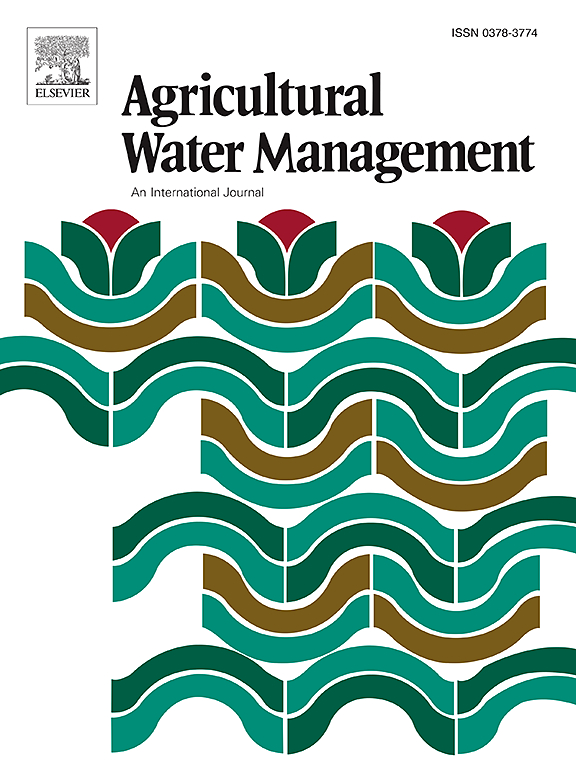结合无人机遥感数据估算日尺度作物水分胁迫指数:提高诊断的时间代表性
IF 5.9
1区 农林科学
Q1 AGRONOMY
引用次数: 0
摘要
利用无人飞行器(UAV)的热红外遥感技术获取作物冠层温度并计算作物水分胁迫指数(CWSI),是一种很有前景的田间水分监测方法。然而,由于热红外数据的昼夜变化性,此类工作往往受限于瞬时尺度。为了解决这一局限性,我们开发了适合无人机遥感的日尺度 CWSI,从而提高了作物水分胁迫诊断的时间代表性。我们以内蒙古河套灌区的春玉米为研究对象,调查了四个关键生长阶段。利用无人机热红外技术获得了白天的多个瞬时统计CWSI(CWSI)值。结合无人机多光谱数据和彭曼-蒙蒂斯模型,得出实际蒸散量和日尺度 CWSI(CWSIt_day)。通过比较不同时间的 CWSIs 和 CWSIt_day 之间的关系,建立了从瞬时 CSWI 到日尺度 CWSI 的时间放大模型。结果表明,与全天 CWSIs 值的波动相比,CWSIt_day 值的波动较小,在九叶期(V9)、抽穗期(VT)、抽丝期(R1)和乳熟期(R3)分别为 0.13、0.09、0.03 和 0.03。CWSIt_day 与不同时期测得的气孔导度(gs)具有更高的相关性,因此更稳定,更具时间代表性。不过,这两个指数可能会将玉米生长末期因衰老而导致的叶片生理活性下降错误地解释为水分胁迫,从而导致 CWSI 值被高估。通过将 12:00、14:00 和 16:00 观测到的 CWSIs 值与随机森林回归算法相结合而建立的时间放大模型的决定系数为 0.794,均方根误差为 0.04。因此,可以有效地利用多个瞬时观测值来代替日尺度观测值,为 CWSIt_day 的推广和应用提供了重要启示。总之,本研究提出了一种基于无人机平台获取高时空分辨率连续 CWSI 值的新方法。本文章由计算机程序翻译,如有差异,请以英文原文为准。
Combining UAV remote sensing data to estimate daily-scale crop water stress index: Enhancing diagnostic temporal representativeness
Using thermal infrared remote sensing from unmanned aerial vehicles (UAVs) to obtain crop canopy temperature and calculate the crop water stress index (CWSI) is a promising method for monitoring field water conditions. However, such endeavors are often constrained to instantaneous scales due to the diurnal variability of thermal infrared data. To address this limitation, we developed a daily-scale CWSI suitable for UAV remote sensing, enhancing the temporal representativeness of crop water stress diagnostics. We focused on spring maize in the Hetao Irrigation District of Inner Mongolia and investigated four key growth stages. UAV thermal infrared was used to obtain multiple instantaneous statistical CWSI (CWSIs) values during the day. UAV multispectral data and the Penman–Monteith model were combined to obtain the actual evapotranspiration and daily-scale CWSI (CWSIt_day). A temporal upscaling model from instantaneous CSWI to daily-scale CWSI was established by comparing the relationships between the CWSIs and CWSIt_day at different times. Results show that compared to the fluctuations of the CWSIs values throughout the day, those of the CWSIt_day values were smaller, with values of 0.13, 0.09, 0.03, and 0.03 during the ninth leaf (V9), tasseling (VT), silking (R1), and milk (R3) stages, respectively. The CWSIt_day demonstrated a higher correlation with the measured stomatal conductance () at different time periods, thereby being more stable and temporally representative. However, both indices may incorrectly interpret the decline in leaf physiological activity due to aging as water stress at the end of maize growth, leading to overestimated CWSI values. The temporal upscaling model, which was developed by combining CWSIs values observed at 12:00, 14:00, and 16:00 with the random forest regression algorithm, achieved coefficient of determination of 0.794 and root mean square error of 0.04. Hence, multiple instantaneous observations can be used effectively instead of daily-scale observations, providing key insights into the popularization and application of the CWSIt_day. Overall, this study presents a new method for obtaining continuous CWSI values with high temporal and spatial resolutions based on a UAV platform.
求助全文
通过发布文献求助,成功后即可免费获取论文全文。
去求助
来源期刊

Agricultural Water Management
农林科学-农艺学
CiteScore
12.10
自引率
14.90%
发文量
648
审稿时长
4.9 months
期刊介绍:
Agricultural Water Management publishes papers of international significance relating to the science, economics, and policy of agricultural water management. In all cases, manuscripts must address implications and provide insight regarding agricultural water management.
 求助内容:
求助内容: 应助结果提醒方式:
应助结果提醒方式:


